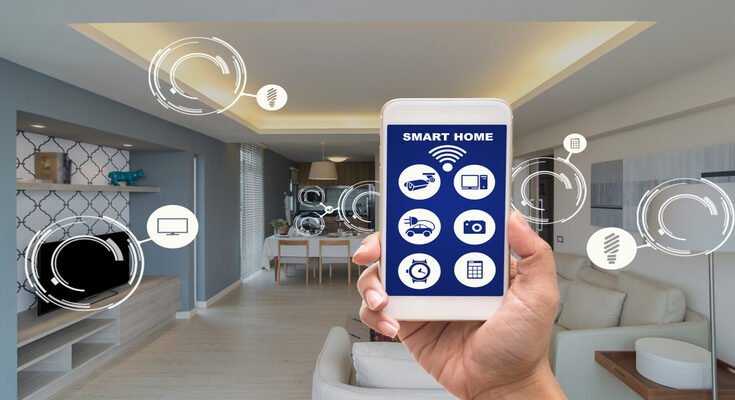Introduction
After the success of smartwatches and wristbands, the next best thing is smart homes. Internet of things IoT is almost everywhere nowadays. A person readily avails the mobile app development services in Delaware or any other state or country. Because of the rapid increase in technology. Smart homes refer to IoT devices. To put it another way, we may assume that these devices control all the lighting systems, appliances, and HVAC (heat ventilator and air conditioner) systems.
On the other hand, it also manages the security cameras, entertainment system, alarms. And the plus point of this is that it also detects the leakages with its sensors. All these devices are sharing the same ecosystem. However, a user can see all the activities via their smart mobile phones.
With the innovations in technologies, smart home devices are gaining popularity. On the other hand, if we see the numbers of the worldwide smart home market is growing. Moreover, it will grow more with time. The main reason for its rapid expansion is safety. And the tag of IoT systems that offer the best quality to its customer and owners. The smart home security system comes at a second number.
On the other hand, it also comes in second place among the fastest-growing technologies. As per Statista, smart home IoT monitoring and home security will go up by 2022. Similarly, devices responsible for safety, light control, voice control, and temperature control capture the market. Such types of devices will bring more changes. On the other hand, it generates more revenue for the manufactures. And the app developer is also making money with such technologies.
How Does This Smart Home Technology Works?
This new technology of smart home allows and help the users to build a pleasing and secure atmosphere. While it enables the users to manage their day-to-day households and task. The smart home system has three main components. The first thing is a hub. The second is sensors, and the last is actuators. However, it also offers devices that help in data exchange. On the other hand, it allows users to manage the device from different locations.
1. Hub
Your smart home system’s brain is the hub. It’s the critical controller that manages all communication and data processing between home automation smart devices. A hub comprises a back end and a client app, a home automation mobile app that allows users to control all of their devices physically. And do the arrangement of automatic responses to specific events. For instance, adjusting the light power in response to the weather conditions.
2. Sensors
Sensors are low-power instruments. Which sense Surroundings conditions. Such as temperature, humidity, noise, movement, and leakages. Sensors don’t have much memory. So, they usually send data straight to the hub. After that, the hub decides what to do with the gathered data. The hub, for example, will send a notification or alert to the client app. Like close the blinds, and unlock the door, etc.
3. Actuators
Actuators are smart appliances. that quickly change their states in response to the commands coming from the hub. Smartwatches, TVs, smart speakers, valves, thermostats, and automatic blinds are all examples of IoT products that use actuators.
All components of a smart home system must interact to function as a single point of control. There are several approaches to connectivity with IoT devices. Let’s discuss them.
Connectivity For Smart Home Devices and Its Types
Mostly in modern smart homes, the hub uses various signals to interact with the rest of the system’s equipment like radio ones. To be precise, there are several networking options:
Wi-Fi is the most popular technique for connecting smart devices to your gateway.
- Advantages: It works with almost all smart devices. It allows devices to connect easily. All the currently available devices that have Wi-Fi ability can connect. On the other hand, it will enable you to access them from anywhere with a Wi-Fi link.
- Drawbacks: Wi-Fi takes much power. And it uses much electricity. This can result in a reduction in battery life.
Bluetooth: enables users to manage home devices directly from their phones or tablets, which act as a gateway.
- Benefits: Bluetooth consumes less battery. Low Energy technology allows for longer battery life. Additionally, this is a cost-effective alternative.
- Disadvantages: Bluetooth’s range is limited. You can’t access it as Wi-Fi.
Z-Wave In this scenario, the “smart house” components interact over a radio channel using local network technology.
- Advantages: Z-wave can communicate, or we can share it share the information with 1500 smart objects at once.
- Disadvantages: Z-wave systems use radio frequencies. That varies depending on where they are using. As a result, when you move to a new city or district, issues arise.
ZigBee is a wireless protocol that is used in Smart Home devices to link to each other.
- Advantages: it is compatible with a wide range of modern devices. On the other hand, such as Samsung, Phillips, etc., it is available in reasonably priced.
- Drawbacks: This system operates at a 2.4 GHz frequency. Which is comparable to Bluetooth and Wi-Fi. As a result, the more devices on the same frequency, the more likely there are chances to get local interferences.
Essential App Features for Smart Home
There are several ways to track or monitor the smart home app. But the critical functionalities of smart homes must include these features.
1. User registration is the first step. Simple registration methods (for example, signing in via social networks) are not appropriate for the smart house app. because it all about data protection. And the app is a concern with it. We recommend that you obtain the user’s name, email address, and phone number. You can even give him a code to verify his identity.
2. The user’s profile: We must create a profile screen for the user after successfully registering him on the app. Furthermore, two types of profiles must be provided:
- Admin (owner) with complete control over the smart home’s mobile monitoring system.
- A regular user with restricted access granted by the admin.
3. The onboarding procedure: Offer some screens of the home control app for the introduction. A quick guide that explains the hub setup and smart device connection principles to its users. On the other hand, if required, you can include audio and video tips in this guide.
4. Page of the Device: This screen displays a list of sensors. That monitor smart home devices such as the thermostat, light, smoke, and water sensors, among others.
5: Sensors Page: Every system should have its screen of management and configuration parameters.
6. Choose a space: This function allows the user to choose a room in the house. On the other hand, it will enable you to control the parameters in that space.
7. Notifications: This is one of the most critical features of the home automation mobile app. It keeps the user informed about what is going on in his home at all times.
Also, read Benefits of a good eCommerce website for your business
End Notes
After getting complete knowledge regarding the smart home automation system, you can go for app development. You have the information that what features to use and what to avoid. What features will satisfy your needs? But you don’t know one thing that how much it will cost you? and so many other things. But don’t worry, there are several companies in the market like Cubix. Such companies have all the answers to your questions. You can contact these companies directly by visiting their website.




